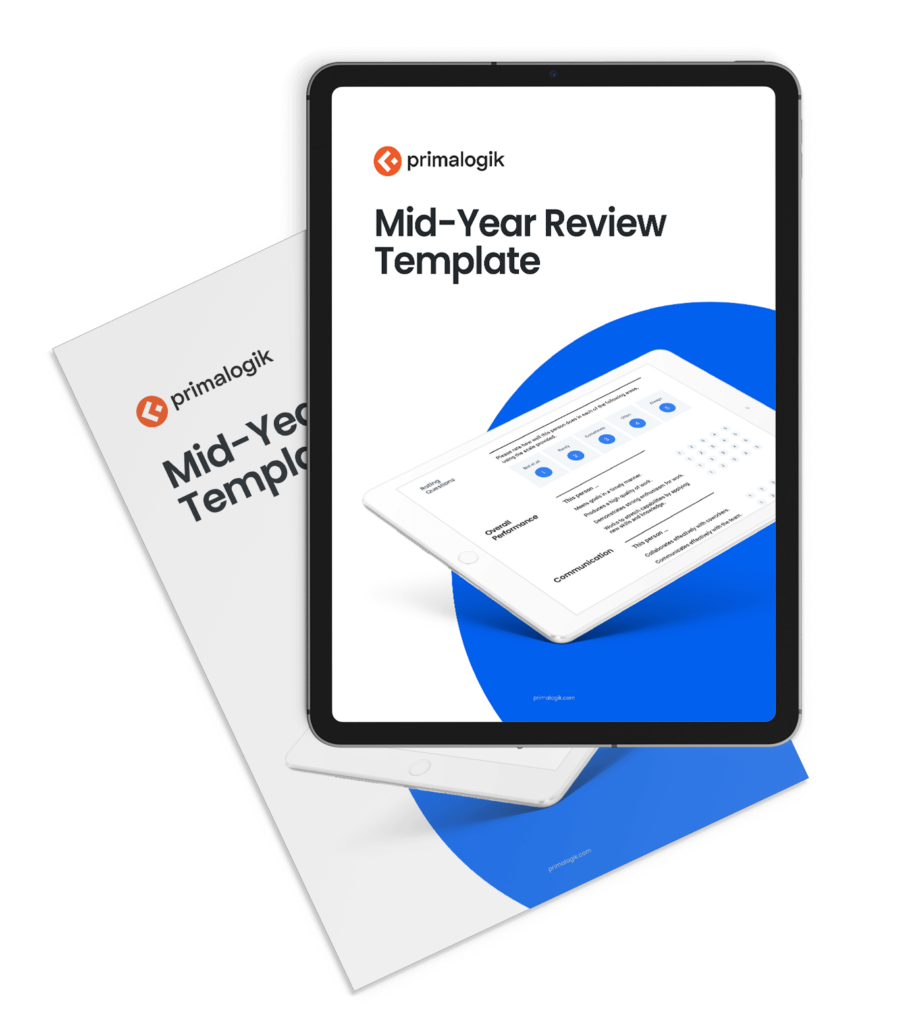Today, it’s a common practice to hold a mid-year review in addition to a year-end review. For hybrid and remote teams, this is especially important since managers may have less chance to observe employees directly.
Holding a one-on-one assessment meeting is one thing – making the most of the process is another. By being prepared and using the right tools, anyone can learn to hold an effective and fruitful mid-year review. Keep reading to learn how in this complete guide to mid-year reviews!
Table of Contents
- Definition of a Mid-Year Review
- Why Should Companies Do Mid-Year Reviews?
- Pros and Cons of Doing Mid-Year Reviews: How Effective Are They, Really?
- How HR Teams Should Prepare for Mid-Year Reviews
- Will Using A Mid-Year Review Template Make a Difference?
- How Managers Should Prepare for Mid-Year Reviews
- How Employees Should Prepare for Mid-Year Reviews
- Top 5 Best Practices for Conducting a Mid-Year Review
- Primalogik Performance Management Software Helps SMEs Carry Out Successful Mid-Year Reviews
Definition of a Mid-Year Review
A mid-year review is a one-on-one meeting where a manager evaluates an employee’s performance. It usually takes the form of a discussion, during which both parties will review the employee’s progress and assess how well they succeeded in reaching their goals during the past six months.
The mid-year review process includes two main elements:
- Preparation for the review.
- The review conversation (which may last 45 minutes to an hour).
We’ll discuss both in a moment. But first, let’s unpack the purpose of the mid-year review.
Why Should Companies Do Mid-Year Reviews?
Today, many companies are prioritizing ongoing feedback. Do these organizations still need mid-year reviews? Absolutely.
“Especially in companies where ongoing feedback has become the norm, it never hurts to remind managers and employees that midyear is a good time to discuss their goals, performance, and development,” says Blakeley Hartfelder, research consultant at Gartner.
The Society for Human Resource Management (SHRM) concurs. “A formal six-month performance appraisal allows for midyear adjustments, preventing surprises at the year-end performance review,” it asserts.
A mid-year review has several key purposes:
- Providing constructive feedback on areas for improvement.
- Recognizing strong work and goals accomplished.
- Eliminating hurdles to goal achievement.
- Rethinking goals when needed.
- Assessing job satisfaction and ways to improve it.
- Providing feedback for the manager and organization.
- Improving employee engagement.
A mid-year review is more than an assessment—it’s a dialogue. While the manager completes a written evaluation beforehand, the review should be a two-way conversation.

Pros and Cons of Doing Mid-Year Reviews: How Effective Are They, Really?
There are some challenges associated with mid-year reviews, but these can usually be overcome with a focused approach. Let’s explore the benefits vs. potential drawbacks of following a biannual review schedule.
Benefits of doing mid-year reviews
A mid-year review often provides more accurate and up-to-date feedback than an annual review. After all, the events being discussed will be fresher in everyone’s mind. Plus, it gives employees a chance to improve before six more months go by.
Further, employee goals must often adapt quickly to changing priorities in today’s workplace. The mid-year review lends a chance for an in-depth review of goals, ensuring they’re current.
Drawbacks of doing mid-year reviews
In some companies, overworked managers may push back against the idea of holding additional performance reviews. However, holding just one annual review proves less effective and may actually create more work. Gathering data and reflecting on performance for an annual review can prove more taxing.
Most managers will struggle to remember what occurred over such a long period of time.
Some companies feel biannual reviews aren’t enough. Instead, they follow a quarterly review cycle. This can prove highly beneficial, giving employees in-depth feedback four times per year. Now, that’s not exactly an argument against holding mid-year reviews. It just means you might consider holding this type of appraisal more often!
How HR Teams Should Prepare for Mid-Year Reviews

There are several things your Human Resources team can do to make mid-year reviews a success.
1. Standardize the process
We strongly advise using performance review software to facilitate a smooth and equitable process. This means requiring all managers to use the same rating scale. All managers should also complete reviews in the same timeframe. And they’ll all answer similar questions.
2. Ask the right mid-year review questions
Select the right questions to answer in your mid-year reviews. These questions will vary depending on an employee’s level, but they should be similar for same-level employees. This will promote equity.
If you’re using performance review software, it will typically include questionnaires, templates and questions that you can customize to meet your needs. Primalogik also offers a dedicated article, in which we present 88 employee review questions to choose from.
Remember to include a self-assessment for employees to complete also.
Use a mid-year review template
Using a mid-year review template will allow you to get off on the right foot. We’ve provided some examples of questions for the written portion of the review below, but go ahead and download our full free template above and turn to it anytime as a starting-point for designing your mid-year reviews.
Will Using A Mid-Year Review Template Make a Difference?
A mid-year review template provides the direction and focus managers need to keep the conversation constructive and respectful. It’s the best way to prepare for a beneficial one-on-one review meeting.
Here’s a quick outline to give you an idea, or you can download the Primalogik review template below:
Please rate employees from 1 to 5, with 5 being the highest, in the following areas.
- Takes initiative to grow new skills 1 2 3 4 5
- Collaborates effectively with coworkers 1 2 3 4 5
- Meets goals in a timely manner 1 2 3 4 5
- Produces a high quality of work 1 2 3 4 5
- Takes accountability for mistakes 1 2 3 4 5
- Communicates effectively with team 1 2 3 4 5
- Manages time wisely 1 2 3 4 5
- Handles stress effectively 1 2 3 4 5
- Shares helpful feedback regularly 1 2 3 4 5
- Listens to others’ feedback and strives to learn from it 1 2 3 4 5
- Demonstrates strong enthusiasm for work 1 2 3 4 5
- Works to stretch capabilities by applying new skills and knowledge 1 2 3 4 5
Please answer the following questions in no more than a few sentences:
- What three aspects of performance does this employee most need to improve?
- Which existing skill(s) should the employee continue to build on and use more often?
- What are the employee’s greatest strengths?
How Managers Should Prepare for Mid-Year Reviews
Managers should get ready for mid-year reviews by using targeted strategies for analysing and assessing employee performance. Here are a few suggestions for ways to guide your reflection process:
- Examine job criteria to make sure you’re using the right standards.
- Refer to the employee’s past review(s). What issues has the employee overcome? What issues persist?
- Look for tangible proof that an employee is succeeding or struggling. If you use a performance management system, you can refer to the data it provides. Prepare examples to share. (For instance, has the number of leads brought in by a marketer ceased to grow?)
- Consider whether the goals set out for this employee or timeframe are still appropriate. Have the team or organization’s goals changed?
- Assess the employee’s workload. Does the employee have a reasonable amount of work? Or is their work-life balance declining?
- Managers can also encourage employees to take steps to prepare for their review meeting.
How Employees Should Prepare for Mid-Year Reviews

Employees do not need to wait for review meetings in a state of worry, feeling powerless to have an impact on the process. On the contrary, any employee can take a few key steps so the review conversation as productive as possible, including learning what to say during the review. Here are our favourite tips for helping employees get ready for mid-year reviews:
1. Review your own performance before the formal review
If you proactively assess your own performance, you’ll brand yourself as a self-starter.
“Try to think of things you have done that have had an impact on the employer that may not have been accomplished without your efforts,” says Anthony DeRosa in The Wall Street Journal. “It can help if you keep a log of your achievements throughout the year that you can draw from to demonstrate your notable contributions. If you have been sharing status reports with your boss regularly, you may go back to them to pull significant items.”
2. Refer to past 360 reviews
Employee reviews may not go as far in-depth as 360 reviews, but that doesn’t mean you can’t refer to previous assessments in the discussion. Look at areas where you’ve worked to grow based on peer feedback. Explain the steps you’ve taken to improve since your last assessment, whatever type of performance evaluation it was.
3. Review your goals and KPIs
Make sure you know what your recent goals were, and are familiar with how successfully you managed to reach them. Now is a good time to outline specific benchmarks that demonstrate you’ve achieved them or made substantial progress, so be prepared by knowing exactly what you have accomplished.
4. Bring questions for your manager
Strive to make the experience a positive one for both you and your manager by showing you want genuine feedback. As you sit down to start the review, say something like, “I’m eager to hear your thoughts on how I could strengthen my skill set over the next few months. I’ve completed a self-assessment, but I’m very interested in your feedback on how I’m performing.”
Then, ask questions like these when the opportunity presents itself:
- What should I do more of? Less of?
- How could I better help you to observe my work? (For example, more detailed project updates.)
- Do my goals align with the company’s current goals?
- How can I set myself up for advancement? What opportunities am I best positioned to aim for?
If you’re aiming for a promotion at the end of the year, ask what you can do to prepare for it during the next six months, says Korn Ferry. Remember that, in many cases, employees must exceed their goals to get promoted.
Think about your next goals as well. Bring specific ambitions to the table that will benefit the company in tangible ways.
Top 5 Best Practices for Conducting a Mid-Year Review

Now let’s examine best practices for writing, delivering, and doing follow-up for a mid-year review. Following these tips and strategies will help managers get the best possible results from these discussions.
1. Learn how to write a mid-year review properly
It’s a good idea to learn how to write a great mid-year review. As mentioned, using performance review software will help you cover all the bases.
- Take note of employee achievements and areas for growth. Express how the team and company have benefited from them.
- Observe any areas of weakness mentioned in historical performance data. For instance, does teamwork need to grow stronger? Does the employee struggle with certain types of tasks, like writing clear project updates?
- Consider the root causes of any issues you’ve noticed. Does the employee lack motivation or do they simply not have the right skills? You’ll need a different strategy, depending.
- Identify priorities they should focus on for the rest of the year.
- Consider how they can use their new skills in their work. Look for ways to stretch their growth.
Keeping an electronic log, as this will allow you to easily refer back to your notes from previous reviews. (A comprehensive performance management system typically offers these tools.) This will help you easily refresh your memory about issues or achievements noted during the past six months.
2. Get ready for holding the mid-year review discussion
During the review discussion, you’ll present the points discussed in your written report. You’ll also ask for employees’ input in these areas. Then, you’ll have a broader conversation focused on the future. It’s important to be prepared so that you can communicate clearly. Learning key performance review phrases in advance can definitely help.
3. Ask open-ended questions
It’s always a good idea to ask several open-ended questions during your mid-year review discussion. These can serve as great conversation starters for launching a supportive dialogue. These types of questions should still be focused on specific performance review topics. Here are a few examples:
- What’s going well in your work?
- Where are you coming up against hurdles or roadblocks?
- How can I better help you move past those hurdles?
Once the conversation has begun, present your observations along with any other key points from your written review. Discuss key reasons for any shortcomings (e.g., lack of interest or motivation vs. need for skill development). If motivation is the issue, discuss ways of improving it.
In some cases, the same strategies will enhance both motivation and skills, like engaging training opportunities. In other cases, employees may feel more engaged by different types of projects or even a new role, according to the Harvard Business Review.
4. Re-assess the employee’s workload
During the mid-year review conversation, share any concerns about the workload you may have. Do you notice the employee volunteering for numerous projects and then seeming overwhelmed? Discuss better strategies for managing time. Help the employee rebalance major priorities, if necessary.
5. Rely on goal-setting strategies to create new milestones for the coming months
To help employees craft new goals, find alignment between emerging strengths and team objectives. Do their new skills fill important gaps in team capabilities? Design goals to meet these needs.
Check in with employees about their career goals, too. Are they aiming for a particular promotion? Help them create a plan to build the necessary skills over the next six months.
Goals can involve working style, too, as HBR points out. Do you want an employee to be more self-directed? Discuss what that would look like in practice and how you can support them in getting there.
The Most Important Steps to Take Following a Mid-Year Review
There are three main gestures managers should make following a mid-year review:
- Write up a summary of the discussion based on your notes and share it with the employee to make sure you’re on the same page.
- During the months following, hold regular one-on-one conversations to discuss progress and get feedback. If the employee is eligible for a more immediate promotion, discuss this matter in a follow-up conversation.
- Also look for patterns across all mid-year reviews. If managers spot patterns, they should ask themselves what the underlying cause might be. Does their own leadership need to improve? Are there other issues affecting employee engagement or well-being that could be addressed? HR can examine patterns and help managers address them as well. For instance, if an entire team lacks engagement, the manager probably needs some coaching.
Primalogik Performance Management Software Helps SMEs Carry Out Successful Mid-Year Reviews
With the right approach, HR teams, managers and employees can all benefit from mid-year reviews. Instead of dreading the process, everyone will look forward to these focused conversations, which allow them to explore topics that are vital to their success.
Primalogik offers a professional performance management suite that includes a dedicated employee reviews module. With multiple options for personalization, this streamlined employee reviews software allows you to connect goals, view previous ratings, and quickly compare results.
Find out firsthand how software can help you manage and implement your mid-year review process. Book a demo today!

